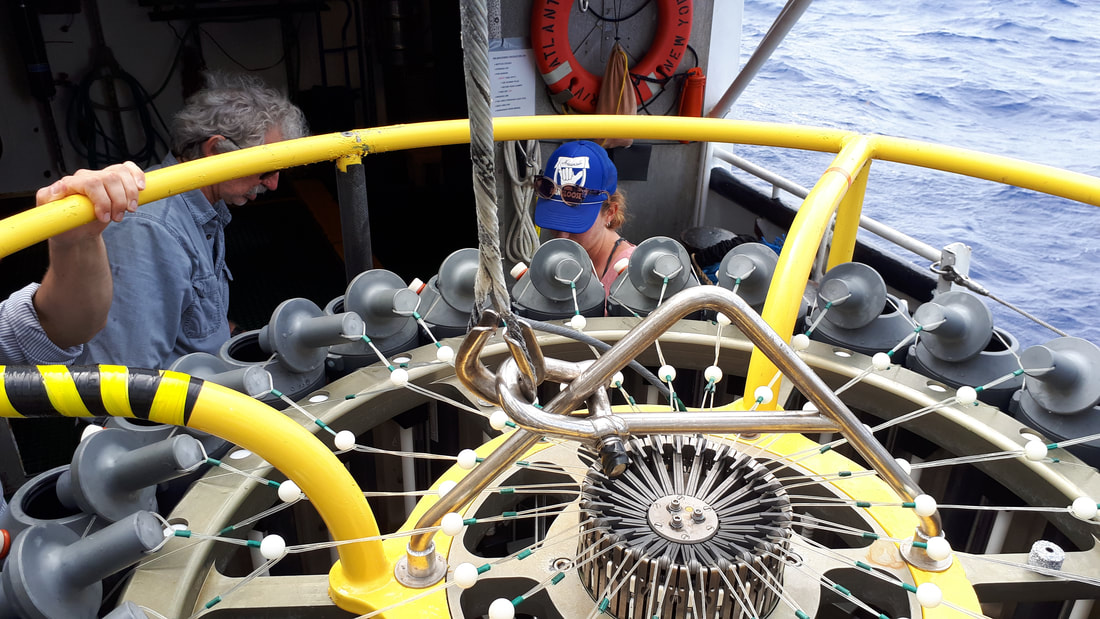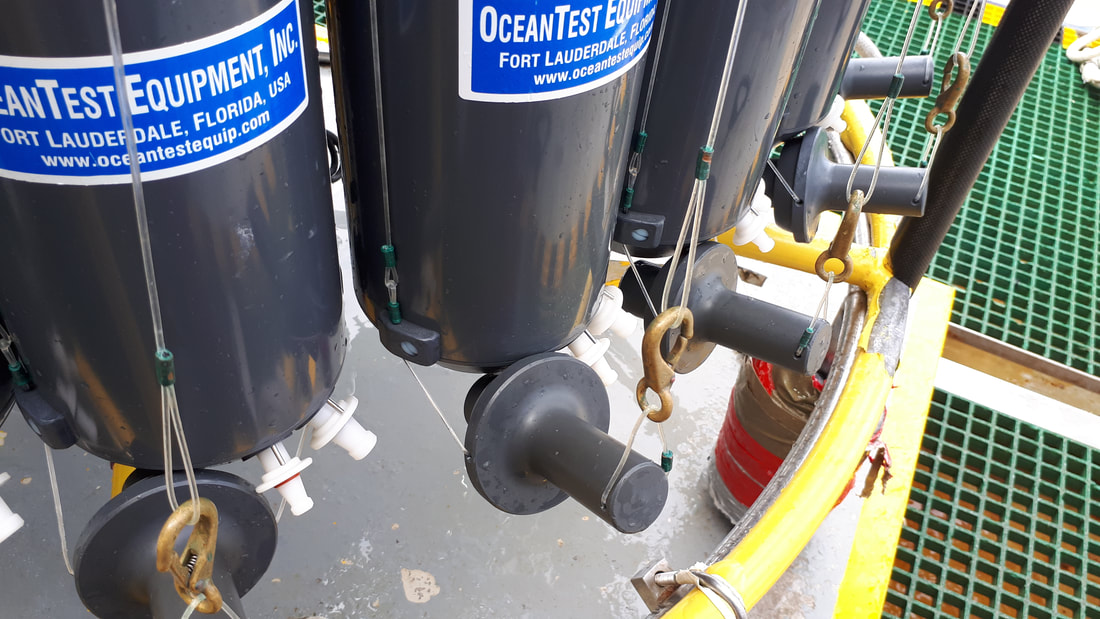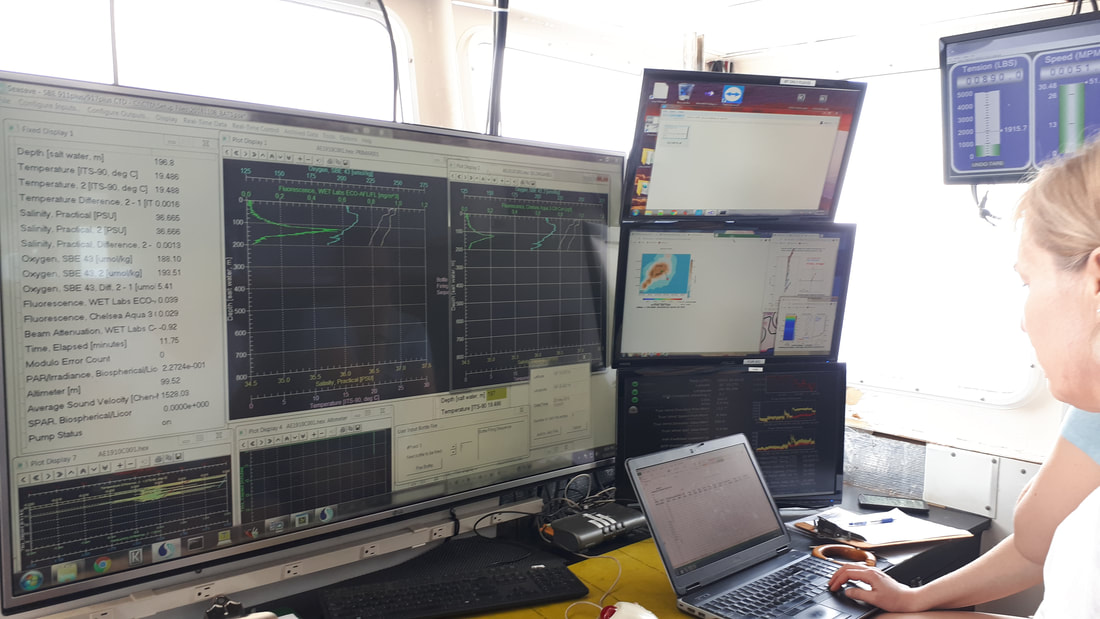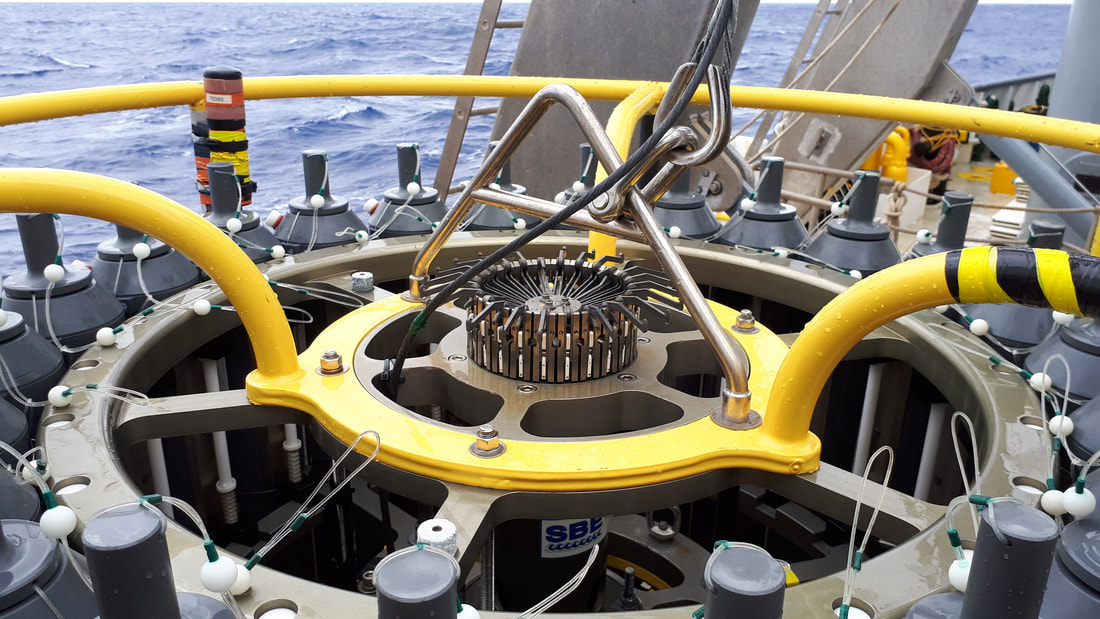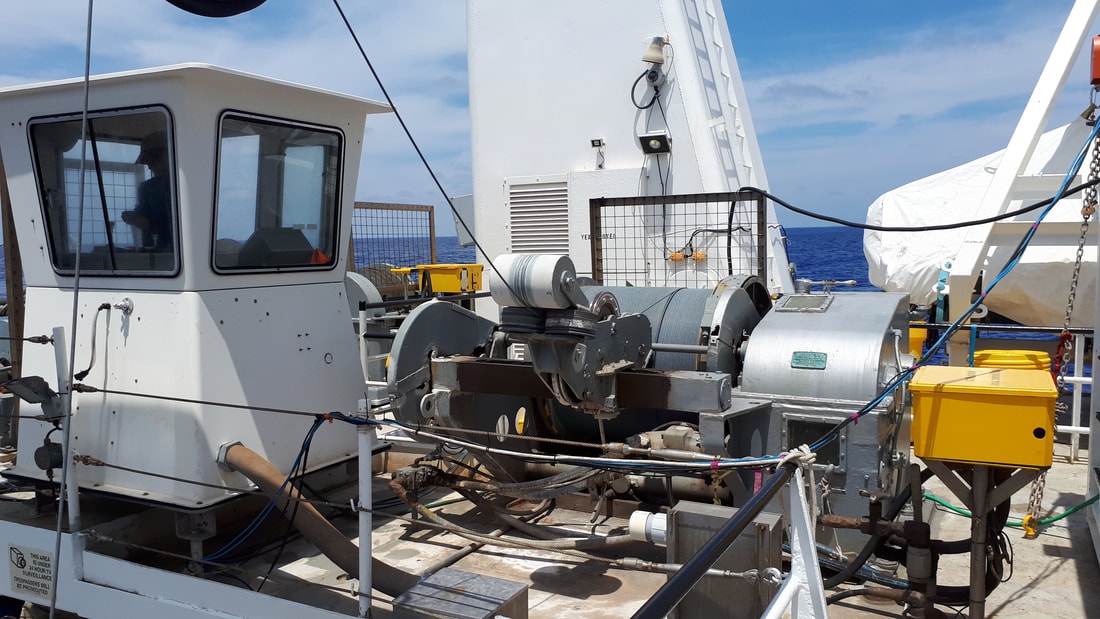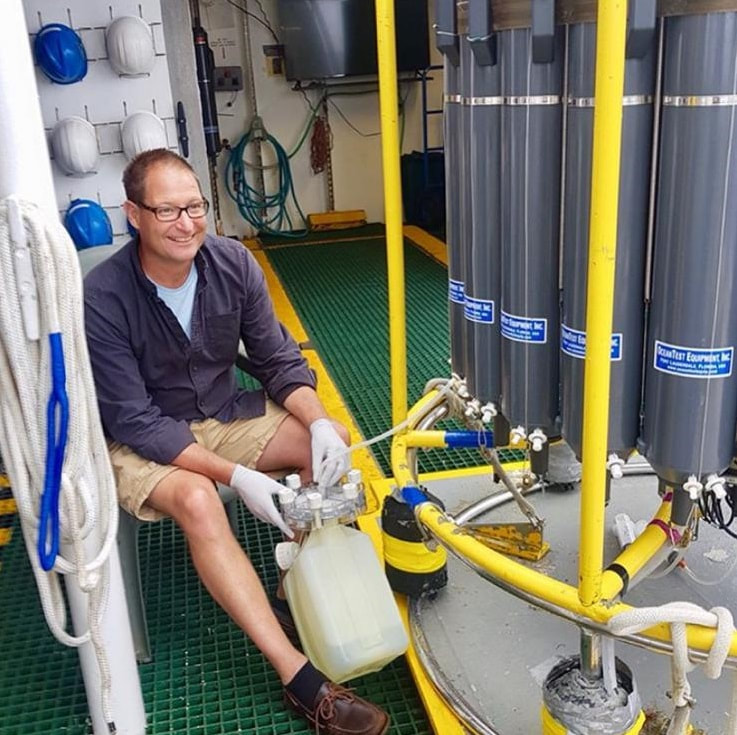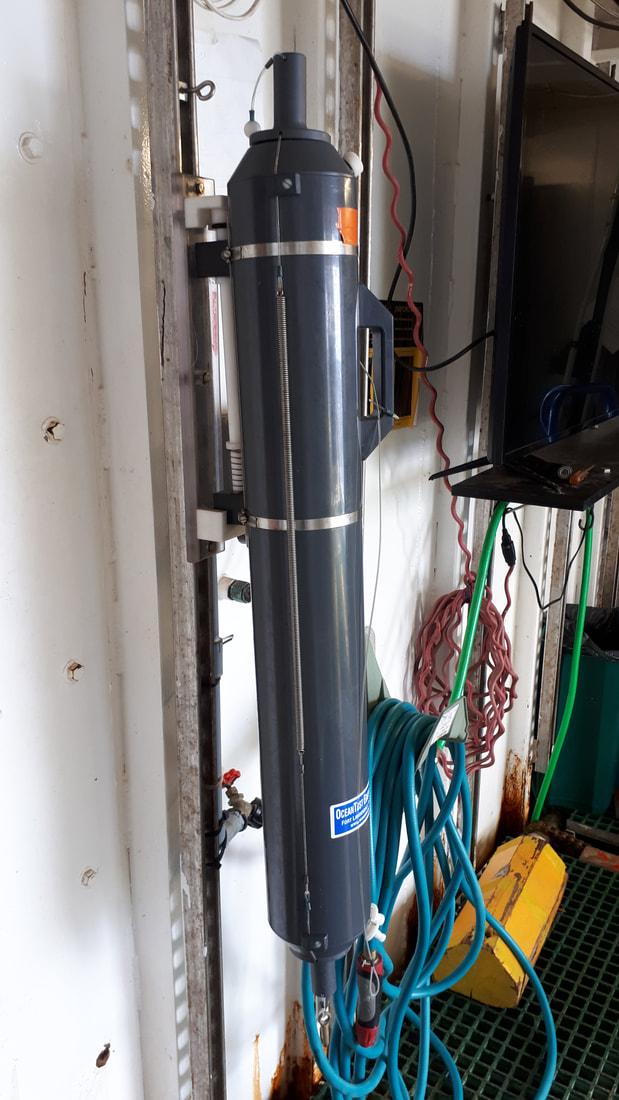|
Moorings >>
|
5.2 - The CTD
Objectives:
- To understand that the CTD is the primary measurement device used by research ships.
- To understand that the CTD can sample the water column at a single point in space and time.
- To know some of the fundamental variables that can be measured using a CTD; conductivity (hence salinity), temperature, pressure (hence depth), dissolved gases, pH and fluorescence.
The most well known and standardised method of sampling the water column remains a large rosette frame loaded with instruments and water sampling bottles, usually just simply called the CTD, which stands for the basic intruments; conductivity, temperature and depth sensors. Surrounding the large frame are special water bottles, called Niskin bottles, that is the standard equipment for sampling the water column. You could in theory use the amount of cable paid out by the winch for the depth, but as the cable gets longer, it gets heavier and starts to stretch – so is not a reliable measuring device. Other sensors such as florescence (to detect photosynthesis) and dissolved oxygen are usually included.
The hydrostatic pressure essential is linear with depth, so correlates well. The conductivity of seawater varies as a function of salinity and temperature, so an accurate temperature reading is required to determine the salinity. The variation of temperature and salinity affects the density of the seawater, so is the major cause of convection and currents. Ocean physics depends on accurate vertical density profiles. The Niskin bottles are open tubes, so that they don’t crush under the pressure, with spring loaded end caps that can be ‘fired’ off by the CTD controller at ‘bottle stops’. As water cannot be compressed the sealed bottles will not explode as the CTD is brought up.
To prep the CTD, the deck crew open and cock the bottles on their trigger levers, check the top air and bottom sampling valves are closed and remove the buffering water syringes from the two conductivity sensors. To deploy can be tricky and dangerous in rough seas. The ship is hove to with the starboard bow in to wind so that that ship is lying about 60 deg to the waves. The cable is taken up to lift the CTD off the deck. It is held under control by two deckhands with ropes to stop it swinging out of control. The crane is then swung outboard and the CTD allowed to swing slowly over the water. Then it is lowered as the guide ropes are released. Once below the surface it is more stable. The danger for the ship is that the CTD barely wobbles as the ships rolls due to the weight of the cable and the drag through the water, so that the loads on the cable vary as the ship rolls. The ship slowly drifts with the wind and waves as the CTD is lowered and raised by the winchman. The winch is a complex piece of machinery that has to pay out the cable under heavy load and bring it back in, without jamming! It is hydraulically powered. The scrolling mechanism on the front enables a neat and tight lying of the cable on the drum – otherwise it would be impossible to stow 6000 m of cable!
The bridge must always be connected with as the ship must be hove to and cannot maneuver while the CTD is over the side. Given that the maximum winching speed is 50 m/min, and the depth on this trip is usually 1000 m, it takes a while to winch it back up! Question: how long? So, the bridge needs to ensure that there is no shipping that could cause issues.
The closing of the Niskin bottles is controlled by the main computer and the depths of the relevant bottle samples is recorded.
Once the CTD is recovered and secured to the deck, the scientists rush out to take the samples from the Niskin bottles to test for a variety of sciency stuff. The sampling is wet and fun, especially with the ship rolling and water occasionally sloshing over the side and under the deck grills. Put the tube on, open the air vent, place tube in bottle and open valve. Rinse twice using the Niskin water jet and then fill the bottle. Easy stuff. There are a wide variety of sampling containers to use. Typical uses for the water samples are testing for:
The hydrostatic pressure essential is linear with depth, so correlates well. The conductivity of seawater varies as a function of salinity and temperature, so an accurate temperature reading is required to determine the salinity. The variation of temperature and salinity affects the density of the seawater, so is the major cause of convection and currents. Ocean physics depends on accurate vertical density profiles. The Niskin bottles are open tubes, so that they don’t crush under the pressure, with spring loaded end caps that can be ‘fired’ off by the CTD controller at ‘bottle stops’. As water cannot be compressed the sealed bottles will not explode as the CTD is brought up.
To prep the CTD, the deck crew open and cock the bottles on their trigger levers, check the top air and bottom sampling valves are closed and remove the buffering water syringes from the two conductivity sensors. To deploy can be tricky and dangerous in rough seas. The ship is hove to with the starboard bow in to wind so that that ship is lying about 60 deg to the waves. The cable is taken up to lift the CTD off the deck. It is held under control by two deckhands with ropes to stop it swinging out of control. The crane is then swung outboard and the CTD allowed to swing slowly over the water. Then it is lowered as the guide ropes are released. Once below the surface it is more stable. The danger for the ship is that the CTD barely wobbles as the ships rolls due to the weight of the cable and the drag through the water, so that the loads on the cable vary as the ship rolls. The ship slowly drifts with the wind and waves as the CTD is lowered and raised by the winchman. The winch is a complex piece of machinery that has to pay out the cable under heavy load and bring it back in, without jamming! It is hydraulically powered. The scrolling mechanism on the front enables a neat and tight lying of the cable on the drum – otherwise it would be impossible to stow 6000 m of cable!
The bridge must always be connected with as the ship must be hove to and cannot maneuver while the CTD is over the side. Given that the maximum winching speed is 50 m/min, and the depth on this trip is usually 1000 m, it takes a while to winch it back up! Question: how long? So, the bridge needs to ensure that there is no shipping that could cause issues.
The closing of the Niskin bottles is controlled by the main computer and the depths of the relevant bottle samples is recorded.
Once the CTD is recovered and secured to the deck, the scientists rush out to take the samples from the Niskin bottles to test for a variety of sciency stuff. The sampling is wet and fun, especially with the ship rolling and water occasionally sloshing over the side and under the deck grills. Put the tube on, open the air vent, place tube in bottle and open valve. Rinse twice using the Niskin water jet and then fill the bottle. Easy stuff. There are a wide variety of sampling containers to use. Typical uses for the water samples are testing for:
- Bacteria
- pH
- Salinity – to calibrate the instruments if required.
- Dissolved solids
- Carbon isotopes
- Other stuff that I don’t know about yet!
- On the Atlantic Explore cruise, some water is bled off through a filter to support the captured copepods while experiments are done on their pooping habits.
BIOS Time Series - the importance of continuous measurements. 7 April 2020
ACTIVITIES
There are a couple of files below that contain CTD data. One is from the Atlantic Explorer cruise in May 2019, the other is from a BIOS field trip with a mini-CTD to St George's Harbour (missing at the moment). These can be used to produce vertical profile graphs of the water column and identify layers and/or changes.
There are a couple of files below that contain CTD data. One is from the Atlantic Explorer cruise in May 2019, the other is from a BIOS field trip with a mini-CTD to St George's Harbour (missing at the moment). These can be used to produce vertical profile graphs of the water column and identify layers and/or changes.
|
| ||||||||||||
Moorings >>
